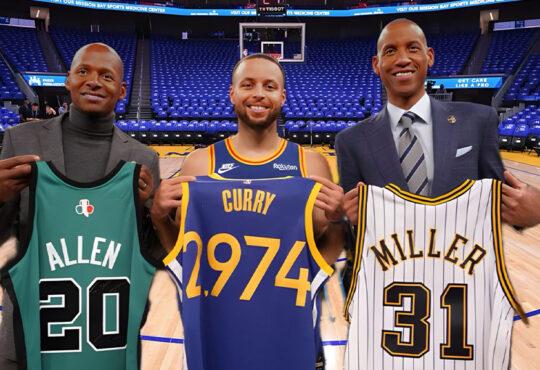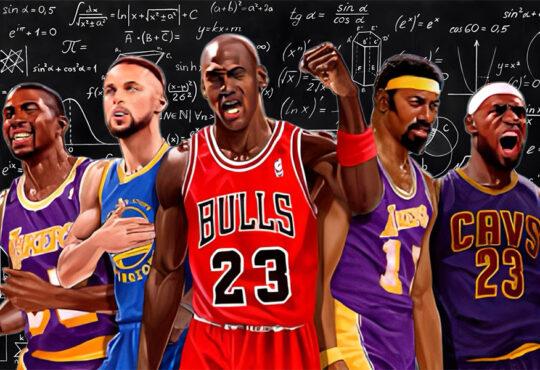
How long is a basketball court?
How long is a basketball court? Of the two major American-invented sports — baseball and basketball — only one has gained worldwide popularity. You can play basketball at any spot of the globe and you can do it with as few as two people and as many as ten. Shoot hoops indoors and outdoors and on any surface hard or flat enough to bounce a ball.
Indoor courts are usually made from hardwood, though other, more easily-maintained surfaces are gaining in popularity. Outdoor courts can be either asphalt or concrete. You can put a permanent basketball court just about anywhere you would like. Don’t have the room for a full-length court? Fitting just a half-court into your driveway, backyard, or commercial gym would be just as useful.
So, have a space in mind and wonder “What are the dimensions of a basketball court?” Let’s take a look at the standard sizes for every level of basketball.
NBA Basketball Court Dimensions
The NBA boasts the largest court dimensions of any level of basketball — domestic or international. The outer dimensions are 94 feet long by 50 feet wide. The half-court line is, as the name would suggest, halfway between each end line. In the middle of the half-court line is a tip-off circle with a six-foot radius, which often sports the home team’s logo.
The key is 16 feet wide and 19 feet from the baseline to the foul line. A semicircle with a six-foot radius extends from the foul line. Some courts have the other side of the half-circle drawn in a dotted line inside the key to complete the circle and create a clear boundary for any jump balls.
The backboard protrudes four feet out from the baseline, and the rim of the basket hangs 10 feet off the ground. Subtracting the four feet overhang from the 19-foot length of the key, we get the familiar 15-foot distance from the foul line to the front of the backboard. It’s a misconception that the foul line is 15 feet from the center of the basket. The backboard itself measures six feet wide and 42 inches high.
Inside the key, a four-foot arc is aligned with the center of the basket to designate the restricted arc. If a defender is inside this semicircle, he cannot draw a charging foul. Along both sides of the key, lines are drawn three feet apart to create the standing positions for other players during a free throw attempt, starting with a box that is seven feet from the baseline and one foot wide.
Outside the key, the three-point line forms an imperfect arc stretching one side of the baseline to the other. The arc isn’t a perfect circle because it would run out of bounds on the sides of the court.
Instead, the three-point line runs in a straight line from the baseline out 16 feet, nine inches, at which point the line begins to curve. The straight lines are even 22 feet from the center of the basket, and on the arc, the distance is 23 feet and nine inches.
Starting at the baseline and running 28 feet toward the center of the court, a line bounds the team bench area. The line also acts as the starting place for inbounds passes after timeouts and fouls.
WNBA Basketball Court Dimensions
The Women’s National Basketball Association or WNBA’s court dimensions are identical to the NBA court in every way except the three-point line. Instead, the distance is equal to the International Basketball Federation (FIBA) at 22.15 feet from the center of the hoop. WNBA teams share arenas and playing surfaces with the NBA, which is why it’s no wonder the court dimensions are so similar.
NCAA Basketball Court Dimensions
National Collegiate Athletic Association or NCAA basketball courts have similar dimensions to the NBA and WNBA, which include the: Court, Foul line, Backboard, Basket height, and Tip-off circle.
That said, there are a few significant differences in the dimensions of the NCAA court. For starters, the key is only 12 feet wide, rather than 16. The first box on the side of the key is only six feet from the baseline, not seven. The restricted area under the basket is also one foot smaller, at three feet in diameter rather than the NBA’s four.
However, the most recognizable difference between the NBA’s court dimensions and the NCAA’s is the distance of the three-point line. The NCAA three-point line is only 20 feet, nine inches from the center of the basket. Because of the smaller diameter, it is a continuous arc from one side of the baseline to the other, with no straight lines necessary to create space on the sidelines.
The difference in three-point line distances is the biggest adjustment for shooters to make as they begin their professional careers, and also why it’s so difficult to project how well a player will shoot in the pros.
FIBA Basketball Court Dimensions
FIBA governs international basketball courts. The measurements for FIBA basketball courts differ from U.S. courts because of the difference between our Imperial measurements — feet and inches — and the more standard metric system.
FIBA courts are even 28 meters long, which converts to almost 92 feet. The 15-meter width converts to just over 49 feet. The tip-off circle is a bit smaller as well, at 3.5 meters in diameter. This difference translates to a radius of about five feet, seven inches.
The key is almost the same size at 5.8 meters long and 4.8 meters wide. These numbers convert to within a few inches of 19 and 16 feet. The basket is 1.2 meters, or almost four feet, in from the baseline, which puts the foul line at 4.6 meters — 15 feet — away. The restricted area under the basket is 1.25 meters or just a shade more than four feet in radius.
The basket is still 10 feet off the ground, which means the biggest difference is the three-point line. At the top of the arc, the three-point line is 6.75 meters from the center of the basket or 22.15 feet. This measurement works out to about 22 feet, two inches. The FIBA three-point line, which has also been adopted by the WNBA, is over a foot and a half closer than the NBA line.
The Story Behind the 10-Foot High Hoop
It would appear the 10-foot basketball hoop is the result of a careful calculation that considers the human anatomy and mechanics of the game. After all, even the tallest players today have to jump to dunk a ball, and a ten-foot-high rim gives a comfortable target to shoot for at a distance. But as we see so often in history, the truth is much more mundane.
When James Naismith dreamed up the game in Springfield, MA in 1891, the railing he chose to hang the baskets on was ten feet off the ground. So, while everything else about the sport has changed since that first game, the baskets are still right where Dr. Naismith hung them.
The History of the Three-Point Line
The three-point line is arguably the most recognizable aspect of a basketball court’s dimensions and part of the reason why is attributed to the history surrounding this semicircle.
The first instance of the three-point line appeared in the American Basketball League in 1961, a full 70 years after Dr. Naismith invented the game. The line was added to increase excitement, but the league folded in just one and a half seasons, so the idea never had a chance.
In 1967, the next competitor to the NBA arrived. The American Basketball Association, or ABA, instituted the three-point line from the very start, and it was a huge success. The ABA had many exciting innovations that produced a better product for the fans. But ultimately, there was not enough room for two professional basketball organizations, so the NBA and ABA merged in 1976.
The three-point line, however, was not included in the merger! The decision-makers in the NBA at the time were too stubborn to adopt such a radical change. They held out for three years before implementing the three-point line in the 1979-1980 season. The NCAA didn’t integrate it until 1986, and it didn’t arrive on high school basketball courts until 1987.
That isn’t the end of the story, however. The line was moved closer for three seasons in the ‘90s to try to boost scoring, but it was quickly moved back to its original place. Taking the idea to the extreme, the NBA has even admitted to having discussions about a four-point line. Ultimately, we’ll believe it when we see it.
What is the difference between American and European basketball
Team Fouls and Bonus Free-Throws
Fiba rules award two free throws for each non-shooting foul after the 4th foul in the same period, so a bonus on the 5th team foul. This includes an individual player’s technical fouls but does not include offensive fouls.
The NBA gives a two free-throw bonus on the 5th team foul or the last two minutes of each quarter. Whichever comes first. The bonus does not include offensive fouls or technical fouls. The WNBA gives a two free-throw bonus on the 8th foul of each half.
NCAA rules award one free throw for each foul, shooting or not, on the 7thm 8th, and 9th foul in each half. If that first free throw was successful they are awarded another free throw. On the 10th and subsequent fouls, the penalty is increased to two free throws. Overtime is basically an extension of the 2nd half. The bonus does not include offensive fouls.
Goaltending – Basket Interference
Global basketball rules do not allow a player to block a basketball on its downward flight to the rim after a shot.
Fiba rules state that once the ball has struck the rim, the defensive player is allowed to clean the ball off of the rim and the offensive player is allowed to dunk/tap it in.
Both the NBA and NCAA propose that there is an imaginary cylinder that exists above the rim. Interfering with the ball in this imaginary cylinder either on offense or defense is a violation.
The NBA has a defensive three-second rule to keep the lane open for more dynamic plays. There is no such defensive three-second in FIBA or NCAA rules.
The Cylinder Rule in Fiba
Arm contact is more permitted in competition outside of Europe. Here on the old continent, you will need to play defense with your legs and not your arms or you will find yourself in foul trouble very quickly. This is one of the main issues with Americans transitioning to European basketball. Stay in front of your man, don’t swipe down at the ball, and use your legs to defend, not your hands. If you get beat don’t try and slow the penetration by using an armbar. You will be called for a foul 90% of the time.
Traveling in Europe Compared to America
Another big issue for Americans transitioning to European basketball is the pivot foot. If you catch the ball with two feet and you take a step with one foot, the ball has to touch the ground via a dribble before you lift your second foot off the ground. If you do this move too quickly, which most Americans are used to in NCAA, you will be called for a travel violation. In transition, a player catching a pass must dribble following the first step on the catch, before the second step.
Closely Guarded Player Rule
Overseas FIBA rules state that if a player, who has the ball in live play, is closely guarded (1 meter or less), they have 5 seconds to pass, dribble or shoot. If 5 seconds pass, there will be a violation and the player will turn the ball over to the other team.
In-Bounds Throw In
FIBA rules require players to inbound the ball straddling the center court line extended at the beginning of all quarters, except the first, as well as all overtimes. The player can pass to either the frontcourt or backcourt.







